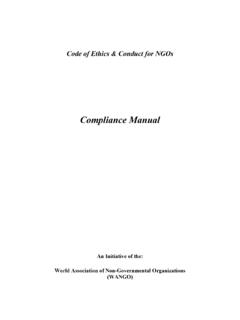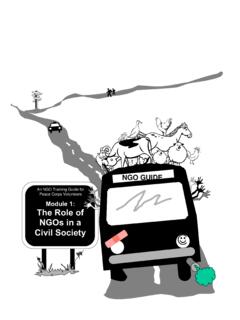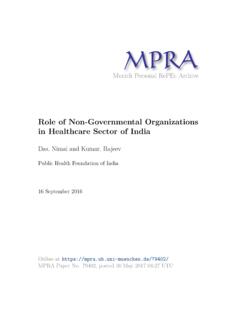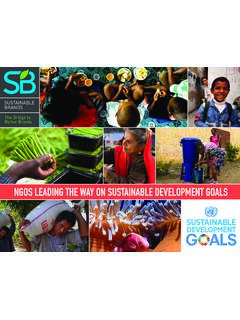Transcription of overview of ngos and civil society1 PHILIPPINES
1 civil society briefs overview of ngos and civil society1 . PHILIPPINES . Country context This brief provides an overview of civil society organizations (CSOs), with a particular focus on The Republic of the PHILIPPINES is located in Southeast nongovernment organizations ( ngos ). Labor unions, Asia, east of Viet Nam. The Philippine archipelago is for the most part, are not addressed in this document. made up of more than 7,000 islands located between the Philippine Sea and the South China Sea. The History of civil society organizations PHILIPPINES was a Spanish colony between 1521 and 1898, and an American colony for nearly half a century. The basis for civil society in the PHILIPPINES is provided After being occupied by Japan during World War II, the by the Filipino concepts of Pakikipagkapwa (holistic PHILIPPINES attained independence on 4 July 1946.)
2 Interaction with others) and kapwa, which means shared inner self . In practice, in the PHILIPPINES , The PHILIPPINES ' political system is modeled after that of voluntary assistance or charity connotes an equal status the United States. The Constitution provides for a between the provider of assistance and the recipient, single 6-year presidential term. The president is chief which is embodied in the terms Damayan (assistance of executive, head of state, and commander-in-chief. The peers in periods of crisis) and Pagtutulungan (mutual legislature is bicameral with a Senate and a House self-help). The Western notion of Kawanggawa (charity). of Representatives. The current President, Gloria may have been introduced to the PHILIPPINES by Catholic Macapagal-Arroyo, assumed her position in 2001 and missionaries.
3 Was popularly elected in May 2004. The Roman Catholic Church and other religious The PHILIPPINES has two official languages, Filipino orders established the first welfare organizations in (based on the dialect Tagalog) and English, as well as the PHILIPPINES during the era of Spanish rule. They eight other dialects. There are many different ethnic established parochial schools, orphanages, asylums, groups Tagalog is the most prominent, comprising and hospitals, such as the San Juan de Dios Hospital almost one-third of the population. Eighty percent of and San Lazaro Hospital. However, these schools and Filipinos are Roman Catholic. Muslims comprise 5% of hospitals were reserved for the local elite. The church the population.
4 Also established Cofrad as (brotherhoods), which encouraged neighborly behavior, such as visiting the The PHILIPPINES , a country of medium human sick and helping with town fiesta preparations, and development, ranks 90th in the world on the United foundations, such as Hermanidad de la Misericordia Nations 2007 Human Development Index (just (brotherhood of mercy). In 1781, Jose de Basco y above Tunisia, and immediately below Ecuador). The Vargas established the Economic Society of Friends, population is nearly 90 million, and adult literacy rate one of the few secular welfare organizations during the stands at About 43% of the population lives on Spanish occupation. less than $1 per day. Life expectancy at birth is 70 years.
5 During the late 19th century, several cofrad as were the University of the PHILIPPINES founded the Philippine established to resist Spanish rule. Some organizations, Rural Reconstruction Movement (PRRM), which claims such as the Cofradia de San Jose, were peasant groups have pioneered an era of rural development and local established to fight for Filipino independence. The democracy in the country. Propaganda Movement, led by the native intelligentsia, sought reforms and equal rights for Filipinos. The Ferdinand Marcos, who became President in 1965, movement used Masonic lodges to spread propaganda envisioned a new society in which there was little ideals and education in collective action. By contrast, space for civil society and no tolerance for advocacy Katipunan was a secular, anti-religious group that ngos .
6 His administration became increasingly associated advocated independence through popular revolution. with the suppression of civil , human, and political rights. Katipunan later inspired student activist groups during the As a result, such organizations either fled underground 1960s and 1970s. All of these were termed asociaciones by joining the armed struggle of the National ilicitas (illegal associations) by the colonial government. Democratic Front or sought shelter from Marcos'. security forces by affiliating with a university or religious The Philippine revolutionary army defeated the Spanish institution, such as the Catholic Church's National in June 1898. Several months later, Spain ceded the Secretariat for Social Action (NASSA), the Share and PHILIPPINES to the Americans in the Treaty of Paris, Care Apostolate for Poor Settlers, the Association of placing the country under colonial rule once again.
7 Major Religious Superior of the PHILIPPINES , etc. Other anti-Marcos organizations operated under innocuous The American colonial government delineated names, such as the Agency for Community Education the boundaries between state provision of public Services and the Organization for Training. The activism goods, religious philanthropy, and private nonprofit of these and other CSOs eventually contributed to the organizations. The Government was generally supportive overthrow of the Marcos regime in the people power . of civil society. For example, the Philippine corporation revolution of 1986, which marked the beginning of a law of 1906 explicitly recognized ngos , and the resurgence in civil society. Government subsidized their operation.
8 American ngos , such as the American Red Cross and the Anti- During the dictatorship, many ngos had built up strong Tuberculosis Society set up branches in the new colony. relationships with poor communities. This was one of The American Methodist and Protestant churches and the reasons why post-Marcos governments partnered the Church of England established schools and hospitals, with ngos in service delivery and public policy. such as Saint Luke's Hospital and Mary Johnston Several pieces of society legislation favorable to civil Hospital. Domestic organizations, such as Asociacion society's development were passed, including the local de Damas Filipinas (organization of Filipino women) government code, the Urban Development and Housing and the Catholic Women's Federation also provided Act, and the Women in Development and Nation welfare services.
9 In 1917, the Associated Charities of Building Act. Government line agencies opened NGO- Manila was established to channel public fund-raising to liaison offices, and ngos were permitted to negotiate charitable institutions and hospitals in the city. directly with bilateral funding institutions for financing. With the support of the Government, hundreds of Many in the Philippine development community began farmer credit cooperatives were born in the 1920s and to welcome NGO management of overseas development 1930s, soon claiming more than 100,000 farmers as assistance, seeing ngos as useful channels for funneling members. At the same time, dissatisfaction among support to needy communities. peasants about rural life fueled growth in membership of the communist movement's labor federation, the The number of ngos mushroomed during the Congress of Labor Organizations (CLO).
10 Administration of President Corazon Aquino. In addition to those with noble pursuits and good intentions were The communist movement stimulated a counterreaction ngos of dubious integrity and engaging in questionable from the Government, religious organizations, and practices. Some of these were established by politicians, non-communist ngos . The Catholic Church expanded businesspersons, and bureaucrats to advance personal, its social agenda to direct engagement with workers rather than public, welfare. In response, 10 of the largest and peasants, while the Jesuits established three anti- NGO networks formed the Caucus of Development communist organizations, the Institute of Social Order NGO Networks (CODE-NGO) in 1991 to promote (1947), the Federation of Free Workers (FFW), and the professionalism, expand reach, and increase the Federation of Free Farmers (FFF).


















